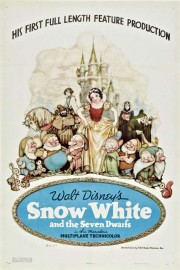Snow White and the Seven Dwarfs
What does it say about me that, not even fifteen minutes into this masterpiece, I was thinking that Walt Disney’s first feature-length animated film would make a damn fine RiffTrax? More importantly, what does it say about the film?
Before I get to answering that question, however, an observation– isn’t it funny that I called it Walt Disney’s first animated feature? Disney wasn’t an animator. He didn’t draw and paint the cels that went into this and many other films that he was associated with. And yet, when we think of “Snow White,” and “Dumbo,” and “Fantasia,” and “Pinoccchio,” and any of the other films Disney’s company made until his death, his is the first, and in some cases, only, name that people mention. It would seem a disservice to the real artists behind these films, but Disney acknowledges, and gives credit where it’s due, by his written appreciation at the beginning of this film, as well as putting the credits of the animators and other people behind the film at the beginning of “Snow White,” while giving himself no on-screen credit.
In many ways, “Snow White and the Seven Dwarfs” is Walt Disney’s “Citizen Kane.” Even though many people do consider some of the studio’s later films during this era superior, “Snow White” set a mighty high bar for everything to follow. (Hell, none other than the great Russian filmmaker, Sergei Eisenstein, called it the greatest film of all-time, at a time when his own masterpiece, “Battleship Potemkin,” was considered that by critics and filmmakers.) And 75 years later, the film is still a wonderful, beautiful treat. It set the template for many of the studio’s great films to come with its lovely princess; its comedic supporting cast of animals and human characters; and an evil stepmother who cares more about herself than our beloved protagonist.
The story should be well-known by now, with so many people taking the Brothers Grimm’s tale in several different directions, up to and including the current television hit, “Once Upon a Time,” and the just-released “Mirror Mirror.” (My other favorite telling is the underseen 1997 fantasy, “Snow White: A Tale of Terror,” which is the gold-standard on the opposite end of the spectrum from Disney.) What struck me about the Disney film when I started watching it was how dark the film is, especially during the scene after Snow White is let go by the huntsman ordered to kill her. The images are dramatic and powerful, and have the potency of a horror film without going too far. (In comparison, “Mirror Mirror” is actually pretty toothless in this regard.) Don’t worry though; in the end, Snow White is saved by her prince, and good defeats evil– it’s still acceptable family entertainment.
And the film is, first and foremost, a triumph in entertainment combined with remarkable artistry. The songs are delightful, and memorable in the greatest Disney tradition (be honest– who hasn’t hummed “Heigh-Ho” or “Whistle While You Work” from time to time), and the personalities of the characters, not just of the human characters but also the animals who come to Snow White’s aid, are unforgettable, although if I’m being completely honest, the dwarfs steal the show (as was almost inevitable with characters named Doc, Happy, Grumpy, Bashful, Sleepy, Sneezy, and Dopey).
However, would the film still be the milestone it is now without the great beauty of its animation? Before “Snow White,” Walt Disney had already established his animators as masters in the field with shorts that not only experimented with techniques such as the multiplane camera and using music as a catalyst for images on the screen, but also introduced the world to characters they would never forget: Mickey Mouse, Donald Duck, Pluto, Goofy. It was only natural, then, that when Disney and his artists took to feature films, they would continue their focus on character and story while also pushing the bounds of what was capable in the medium of animation. Without them, it’s less likely we’d be blessed with the work of Pixar, or Hayao Miyazaki, or any of the other animators who have followed in the footsteps of Walt and those who took his vision seriously, and have given us so many indelible images over the years, which include, from this film: the evil queen’s transformation into a witch, who will tempt her with a poisoned apple; the charismatic forest animals who help Snow White in cleaning the Dwarfs’s house; the image of the queen asking her magic mirror who the fairest of them all is; the sparkle of the Dwarfs’s diamond mine; and finally, the poisoned Snow White, and Prince Charming giving her Love’s First Kiss to break the curse.
I’ll close this review by going back to one of my original questions: What does it say about “Snow White and the Seven Dwarfs” that I think it would make a damn fine RiffTrax? In the end, it doesn’t say a thing about the film’s quality (which still among the highest in film history), but watching squirrels wash dishes, or dwarfs riding deer to rescue Snow White, and the silliness of Snow’s original interactions with the woodland creatures, I couldn’t help but think that, like they proved with their track for another great classic (“Casablanca”), Mike Nelson, Kevin Murphy, and Bill Corbett could find fertile, comedic ground within the frames of another one of cinema’s greatest achievements. For now, I’ll just have to imagine the possibilities on my own. Hopefully, Walt would take it as a compliment that I care enough about his film to put such thought towards it.










